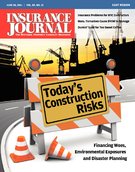Homeowners in western Massachusetts have filed $90 million in insurance claims for damage caused by deadly tornadoes that ravaged Springfield and several smaller communities earlier this month.
The state Division of Insurance estimate is the largest in recent memory from any natural disaster in the state, and the figure is expected to rise.
Barbara Anthony, undersecretary of the Office of Consumer Affairs and Business Regulation, said 5,000 claims for property damage have been filed. Only a few of those were for businesses, and many homeowners are still in the filing process.
“It’s a little premature to predict what the total will be or what the outcome will be at this time, but this is a big step,” Anthony said after touring the damage.
Three tornadoes struck the area June 1, killing three people and injuring hundreds. The storm pulverized or sheared off the tops of roofs on Main Street in Springfield, a city of more than 150,000, about 90 miles west of Boston. A mounted video camera captured dramatic footage of a debris-filled funnel as it swept into downtown from the west, then swirling across the Connecticut River.
The Bay State averages about two tornadoes per year, but Massachusetts hasn’t experienced a tornado since 2008, according to the Storm Prediction Center in Norman, Okla. The last killer tornado in Massachusetts was on May 29, 1995, when three people died in Great Barrington, a town along the New York state border. The state’s deadliest recorded tornado, in 1953, killed 94 people in the Worcester area.
The storm hit as workers were starting the evening commute home. Police closed some highway ramps leading into Springfield. A tornado watch had been issued earlier for much of the East Coast, including Philadelphia, New York and Boston.
Anthony’s office has set up field offices in Springfield, Southbridge, and Palmer to help residents file claims and answer questions about insurance policies and hiring contractors.
Many homes were damaged by fallen trees and while insurance companies cover damage caused by falling trees and removal of the tree, many residents weren’t sure if their insurance covers the removal of fallen trees that did not damage property, said Anthony.
“We’re hoping the claims will be paid and most damage will be covered,” she said.
Officials estimate more than 200 homes in the Springfield area were destroyed by the tornadoes, along with two public schools. The Massachusetts School Building Authority, which reimburses school departments on a sliding scale for construction and building improvement projects, plans to partially reimburse the communities for repairs or rebuilding of the schools.
Funding for the agency comes from a percentage of the state sales tax. Its budget is separate from the state and local education budgets.
The state must reach the threshold of $8.3 million in uninsured losses to receive federal aid. Federal emergency management teams have been assessing the damage to homes and public infrastructure to determine if the state qualifies for aid.
Gov. Deval Patrick has also filed a $52 million supplemental spending plan to help communities with relief efforts. The plan includes $10 million to help pay for emergency response.
Topics Catastrophe Natural Disasters Windstorm Massachusetts
Was this article valuable?
Here are more articles you may enjoy.


 JPMorgan Client Who Lost $50 Million Fortune Faces Court Setback
JPMorgan Client Who Lost $50 Million Fortune Faces Court Setback  Investment Funds File New Suits Over Lighthouse Insurance Collapse in 2022
Investment Funds File New Suits Over Lighthouse Insurance Collapse in 2022  Why New York’s Attorney General Objects to Trump’s Bond Insurer
Why New York’s Attorney General Objects to Trump’s Bond Insurer  Trump’s Bond Insurer Tells Judge Shortfall Is ‘Inconceivable’
Trump’s Bond Insurer Tells Judge Shortfall Is ‘Inconceivable’ 


